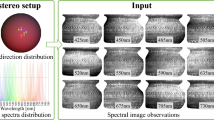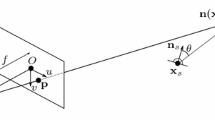Abstract
We tackle the nonlinear problem of photometric stereo under close-range pointwise sources, when the intensities of the sources are unknown (so-called semi-calibrated setup). A variational approach aiming at robust joint recovery of depth, albedo and intensities is proposed. The resulting nonconvex model is numerically resolved by a provably convergent alternating minimization scheme, where the construction of each subproblem utilizes an iteratively reweighted least-squares approach. In particular, manifold optimization technique is used in solving the corresponding subproblems over the rank-1 matrix manifold. Experiments on real-world datasets demonstrate that the new approach provides not only theoretical guarantees on convergence, but also more accurate geometry.
This work was supported by the ERC Consolidator Grant “3D Reloaded”.
Access this chapter
Tax calculation will be finalised at checkout
Purchases are for personal use only
Similar content being viewed by others
References
Woodham, R.J.: Photometric method for determining surface orientation from multiple images. Opt. Eng. 19, 139–144 (1980)
Koppal, S.J., Narasimhan, S.G.: Novel depth cues from uncalibrated near-field lighting. In: Proceedings of the ICCV (2007)
Papadhimitri, T., Favaro, P.: Uncalibrated near-light photometric stereo. In: Proceedings of the BMVC (2014)
Liao, J., Buchholz, B., Thiery, J.M., Bauszat, P., Eisemann, E.: Indoor scene reconstruction using near-light photometric stereo. IEEE Trans. Image Process. 26, 1089–1101 (2017)
Nie, Y., Song, Z., Ji, M., Zhu, L.: A novel calibration method for the photometric stereo system with non-isotropic LED lamps. In: Proceedings of the RCAR (2016)
Cho, D., Matsushita, Y., Tai, Y.-W., Kweon, I.: Photometric stereo under non-uniform light intensities and exposures. In: Leibe, B., Matas, J., Sebe, N., Welling, M. (eds.) ECCV 2016. LNCS, vol. 9906, pp. 170–186. Springer, Cham (2016). doi:10.1007/978-3-319-46475-6_11
Quéau, Y., Wu, T., Lauze, F., Durou, J.D., Cremers, D.: A non-convex variational approach to photometric stereo under inaccurate lighting. In: Proceedings of the CVPR (2017)
Xie, W., Dai, C., Wang, C.C.L.: Photometric stereo with near point lighting: a solution by mesh deformation. In: Proceedings of the CVPR (2015)
Mecca, R., Wetzler, A., Bruckstein, A.M., Kimmel, R.: Near field photometric stereo with point light sources. SIAM J. Imaging Sci. 7, 2732–2770 (2014)
Mecca, R., Quéau, Y., Logothetis, F., Cipolla, R.: A single-lobe photometric stereo approach for heterogeneous material. SIAM J. Imaging Sci. 9, 1858–1888 (2016)
Hartley, R.I., Zisserman, A.: Multiple View Geometry in Computer Vision, 2nd edn. Cambridge University Press, Cambridge (2004)
Koch, O., Lubich, C.: Dynamical lowrank approximation. SIAM J. Matrix Anal. Appl. 29, 434–454 (2007)
Vogel, C.R., Oman, M.E.: Iterative methods for total variation denoising. SIAM J. Sci. Comput. 17, 227–238 (1996)
Chan, T.F., Mulet, P.: On the convergence of the lagged diffusivity fixed point method in total variation image restoration. SIAM J. Numer. Anal. 36, 354–367 (1999)
Nikolova, M., Chan, R.H.: The equivalence of half-quadratic minimization and the gradient linearization iteration. IEEE Trans. Image Process. 16, 1623–1627 (2007)
Hintermüller, M., Wu, T.: Nonconvex TV\(^q\)-models in image restoration: analysis and a trust-region regularization-based superlinearly convergent solver. SIAM J. Imaging Sci. 6, 1385–1415 (2013)
Hintermüller, M., Wu, T.: A superlinearly convergent \(R\)-regularized Newton scheme for variational models with concave sparsity-promoting priors. Comput. Optim. Appl. 57, 1–25 (2014)
Boumal, N., Mishra, B., Absil, P.A., Sepulchre, R.: Manopt, a Matlab toolbox for optimization on manifolds. J. Mach. Learn. Res. 15, 1455–1459 (2014)
Author information
Authors and Affiliations
Corresponding author
Editor information
Editors and Affiliations
Rights and permissions
Copyright information
© 2017 Springer International Publishing AG
About this paper
Cite this paper
Quéau, Y., Wu, T., Cremers, D. (2017). Semi-calibrated Near-Light Photometric Stereo. In: Lauze, F., Dong, Y., Dahl, A. (eds) Scale Space and Variational Methods in Computer Vision. SSVM 2017. Lecture Notes in Computer Science(), vol 10302. Springer, Cham. https://doi.org/10.1007/978-3-319-58771-4_52
Download citation
DOI: https://doi.org/10.1007/978-3-319-58771-4_52
Published:
Publisher Name: Springer, Cham
Print ISBN: 978-3-319-58770-7
Online ISBN: 978-3-319-58771-4
eBook Packages: Computer ScienceComputer Science (R0)




